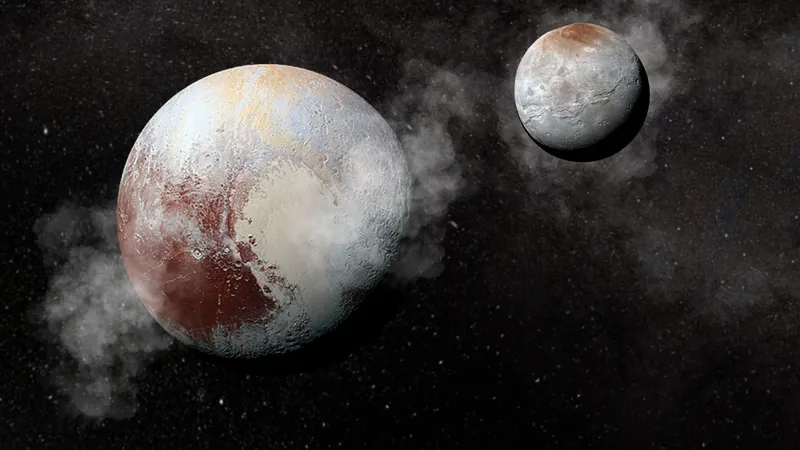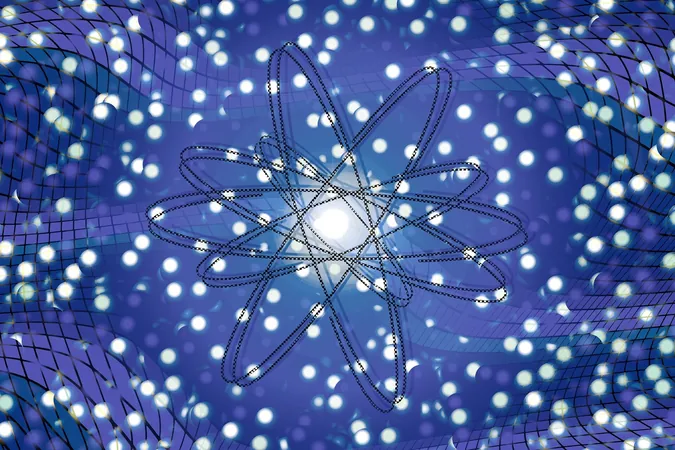
The Fascinating 'Kiss' Behind Pluto and Its Largest Moon Charon: A Cosmic Love Story
2025-01-06
Author: Wei
Introduction
New research uncovers an astounding discovery regarding Pluto and its largest moon, Charon. According to a recent study led by scientists at the University of Arizona, billions of years ago, Pluto may have captured Charon through a fleeting and unique interaction referred to as an icy 'kiss.' This groundbreaking theory aims to clarify how this dwarf planet, which many still affectionately wish to categorize as a full-fledged planet, could grasp onto a moon nearly half its size.
The Cosmic Snowman
The researchers propose that this captivating scenario unfolded during a collision between two icy bodies in the Kuiper Belt, a distant ring of celestial objects beyond Neptune. Rather than obliterating one another, these frigid worlds united, forming an unusual spinning construct termed a 'cosmic snowman.' Although they later separated, they remained gravitationally bound, eventually leading to the current Pluto-Charon system we observe.
Insights into Moon Capture
This 'kiss-and-capture' mechanism provides fresh insights into the dynamics of moon capture and planetary collisions, presenting an innovative take that could enhance our understanding of the structural integrity of icy bodies within the Kuiper Belt. “If we consider Pluto and Charon as solid entities, it's indeed plausible for Pluto to capture Charon following a significant impact,” elucidated team leader Adeene Denton.
Binary Relationship
The relationship between Pluto and Charon poses challenges for scientists due to their comparable sizes and masses. “Charon is extraordinarily large, to the extent that they practically function as a binary system,” Denton elaborated. Charon’s significant size and mass (12% of Pluto's) allow it to resemble Earth's moon more than any other satellite in our solar system, dwarfing our Moon, which is merely a quarter the size of Earth.
Mechanics of the Kiss
So how did this peculiar cosmic 'kiss' occur? Denton suggests that during the initial collision, Pluto experienced an impact that temporarily merged with Charon for a brief period of 10 to 15 hours, which defines the “kiss.” Unlike typical collision scenarios that generally result in a 'hit-and-run,' this phenomenon adds a layer of complexity fundamental to understanding moon formation on a larger scale across the Kuiper Belt.
Icy Bodies and Collision Models
Interestingly, the study also points out how the icy nature of these celestial bodies complicates traditional collision models previously used for assessing more massive, fluid-like objects. By employing simulations that take into account the strength of Pluto and Charon's icy structure, researchers discovered that the two bodies hardly merged deeply enough to become one, leading them to re-establish their independent orbits.
Wider Implications
The implications of this research extend beyond Pluto and Charon. Denton notes that similar mechanisms may explain the orbital relationships of other large Kuiper Belt objects, such as Eris and Orcus. The revelation opens new questions about how these capture events may replicate across the icy expanse beyond Neptune.
Future Research
As scientists delve deeper into the mysteries of the Kuiper Belt, they aim to investigate long-term tidal evolution, hoping to verify their theories about the complex relationship between Pluto and Charon and potential oceans forming within their icy surfaces. Denton emphasizes the importance of understanding the thermal conditions during the original interaction to explore its geological ramifications today.
Conclusion
This eye-opening research, published in the prestigious journal Nature Geoscience, not only provides a captivating narrative of cosmic connection but also deepens our comprehension of the relentless dances of celestial bodies far beyond our own Earthly realms. As humanity's knowledge of the universe expands, we uncover more secrets behind the enchanting relationships that define the cosmos, revealing that even space has its own poetic stories.



 Brasil (PT)
Brasil (PT)
 Canada (EN)
Canada (EN)
 Chile (ES)
Chile (ES)
 Česko (CS)
Česko (CS)
 대한민국 (KO)
대한민국 (KO)
 España (ES)
España (ES)
 France (FR)
France (FR)
 Hong Kong (EN)
Hong Kong (EN)
 Italia (IT)
Italia (IT)
 日本 (JA)
日本 (JA)
 Magyarország (HU)
Magyarország (HU)
 Norge (NO)
Norge (NO)
 Polska (PL)
Polska (PL)
 Schweiz (DE)
Schweiz (DE)
 Singapore (EN)
Singapore (EN)
 Sverige (SV)
Sverige (SV)
 Suomi (FI)
Suomi (FI)
 Türkiye (TR)
Türkiye (TR)
 الإمارات العربية المتحدة (AR)
الإمارات العربية المتحدة (AR)